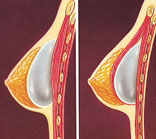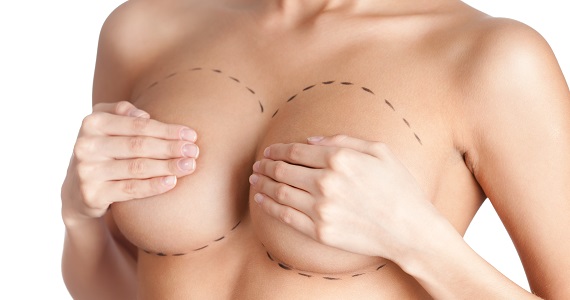

Breast Augmentation Specialists in Savannah, GA
Locations Also in Hilton Head, , Statesboro, Effingham, GA, Bluffton, Vidalia, Richmond Hill & Claxton
Watch What Our Patients Are Saying About Breast Augmentation
The surgeons of The Georgia Institute For Plastic Surgery are skilled Savannah aesthetic plastic surgeons who offer a range of breast cosmetic surgery procedures. The most popular of these procedures is breast augmentation. In the paragraphs below they explain the breast augmentation procedure (technically known as augmentation mammaplasty) and the expected outcomes. You can also view before and after photos of breast augmentation patients, as well as results of patients from across Georgia (GA) and South Carolina (SC).
What is breast augmentation?
Breast augmentation is a cosmetic surgery procedure that increases the size of a woman’s breasts. A saline filled implant with a silicone shell is placed under the breast, which increases the breast size. In the past, silicone gel-filled implants were used for breast augmentation, but the FDA removed this type of implant in 1992 to perform further studies on the safety. With continual research being performed to further improve breast augmentation, the introduction of different types of implant material has the possibility of becoming available in the future.
Who is the best candidate for a breast augmentation?

Breast augmentation is usually done to balance a difference in breast size, to improve body contour or as a reconstructive technique following surgery.
Breast augmentation in Savannah, Georgia can enhance your appearance and your self-confidence, but it won’t necessarily change your looks to match your ideal, or cause other people to treat you differently. Before you decide to have surgery, think carefully about your expectations and discuss them with your Georgia institute surgeon.
The best candidates for breast augmentation are women who are looking for improvement, not perfection, in the way they look. If you’re physically healthy and realistic in your expectations, you may be a good candidate.
Types of Implants
A breast implant is a silicone shell filled with either silicone gel or a salt-water solution known as saline.
Because of concerns that there is insufficient information demonstrating the safety of silicone gel-filled breast implants, the Food and Drug Administration (FDA) has determined that, at the present time, new gel-filled implants should be available only to women participating in approved studies. Some women requiring replacement of the implants may also be eligible to participate in the study.
Breast Augmentation cost:
| Breast Augmentation: | |
Saline Implants | $4990 – $5200 |
Silicone Implants | $6080 – $6125 |

Incisions are made to keep scars as inconspicuous as possible, in the breast crease, around the nipple or in the armpit. Breast tissue and skin is lifted to create a pocket for each implant.
Saline-filled implants continue to be available to breast augmentation patients on an unrestricted basis, pending further FDA review. You should ask your doctor more about the specifics of the FDA decisions.
Breast Augmentation Surgery Risks
Breast augmentation is relatively straightforward. But as with any operation, there are risks associated with surgery and specific complications associated with this procedure. The most common problem, capsular contracture, occurs if the scar or capsule around the implant begins to tighten. This squeezing of the soft implant can cause the breast to feel hard. Capsular contracture can be treated in several ways, and sometimes requires either removal or “scoring” of the scar tissue, or perhaps removal or replacement of the implant.
As with any surgical procedure, excessive bleeding following the operation may cause some swelling and pain. If excessive bleeding continues, another operation may be needed to control the bleeding and remove the accumulated blood. A small percentage of women develop an infection around an implant. This may occur at any time, but is most often seen within a week after surgery. In some cases, the implant may need to be removed for several months until the infection clears. A new implant can then be inserted.

A small percentage of women develop an infection around an implant. This may occur at any time, but is most often seen within a week after surgery. In some cases, the implant may need to be removed for several months until the infection clears. A new implant can then be inserted.
Underlying fat, along with excess skin and muscle, can be removed during the operation. Some women report that their nipples become oversensitive, under sensitive, or even numb. You may also notice small patches of numbness near your incisions. These symptoms usually disappear within time, but may be permanent in some patients.

There is no evidence that breast implants will affect fertility, pregnancy, or your ability to nurse. If, however, you have nursed a baby within the year before augmentation, you may produce milk for a few days after surgery. This may cause some discomfort, but can be treated with medication prescribed by your doctor.
Occasionally, breast implants may break or leak. Rupture can occur as a result of injury or even from the normal compression and movement of your breast and implant, causing the man-made shell to leak. If a saline-filled implant breaks, the implant will deflate in a few hours and the salt water will be harmlessly absorbed by the body.
If a break occurs in a gel-filled implant, however, one of two things may occur. If the shell breaks but the scar capsule around the implant does not, you may not detect any change. If the scar also breaks or tears, especially following extreme pressure, silicone gel may move into surrounding tissue. The gel may collect in the breast and cause a new scar to form around it, or it may migrate to another area of the body. There may be a change in the shape or firmness of the breast. Both types of breaks may require a second operation and replacement of the leaking implant. In some cases, it may not be possible to remove all of the silicone gel in the breast tissue if a rupture should occur.

A few women with breast implants have reported symptoms similar to diseases of the immune system, such as scleroderma and other arthritis-like conditions. These symptoms may include joint pain or swelling, fever, fatigue, or breast pain. Research has found no clear link between silicone breast implants and the symptoms of what doctors refer to as “connective-tissue disorders,” but the FDA has requested further study.
While there is no evidence that breast implants can cause breast cancer, they may change the way mammography is done to detect cancer. When you request a routine mammogram, be sure to go to a radiology center where technicians are experienced in the special techniques required to get a reliable x-ray of a breast with an implant. Additional views will be required. Ultrasound examinations may be of benefit in some women with implants to detect breast lumps or to evaluate the implant.
While the majority of women do not experience these complications, you should discuss each of them with your physician to make sure you understand the risks and consequences of breast augmentation.
Planning Your Breast Implant Surgery
In your initial consultation, your surgeon will evaluate your health and explain which surgical techniques are most appropriate for you, based on the condition of your breasts and skin tone. If your breasts are sagging, your doctor may also recommend a breast lift.
Be sure to discuss your expectations frankly with your surgeon. He or she should be equally frank with you, describing your alternatives and the risks and limitations of each. You may want to ask your surgeon for a copy of the manufacturer’s insert that comes with the implant he or she will use — just so you are fully informed about it. And, be sure to tell your surgeon if you smoke, and if you’re taking any medications, vitamins, or other drugs.
Your surgeon should also explain the type of anesthesia to be used, the type of facility where the surgery will be performed, and the costs involved. Because most insurance companies do not consider breast augmentation to be medically necessary, carriers generally do not cover the cost of this procedure.
Pre-Surgery Details
Your surgeon will give you instructions to prepare for surgery, including guidelines on eating and drinking, smoking and taking or avoiding certain vitamins and medications.
While making preparations, be sure to arrange for someone to drive you home after your surgery and to help you out for a few days, if needed.
Where Your Surgery Will Be Performed
Your surgeon may prefer to perform the operation in our Savannah breast augmentation surgical facility, a freestanding surgery center, or a hospital outpatient facility. Occasionally, the surgery may be done as an inpatient in a hospital, in which case you can plan on staying for a day or two.
Types of Anesthesia
The method of inserting and positioning your implant will depend on your anatomy and your surgeon’s recommendation. The incision can be made either in the crease where the breast meets the chest, around the areola (the dark skin surrounding the nipple), or in the armpit. Every effort will be made to assure that the incision is placed so resulting scars will be as inconspicuous as possible.
Working through the incision, the surgeon will lift your breast tissue and skin to create a pocket, either directly behind the breast tissue or underneath your chest wall muscle (the pectoral muscle). The implants are then centered beneath your nipples.
Some surgeons believe that putting the implants behind your chest muscle may reduce the potential for capsular contracture. Drainage tubes may be used for several days following the surgery. This placement may also interfere less with breast examination by mammogram than if the implant is placed directly behind the breast tissue. Placement behind the muscle however, may be more painful for a few days after surgery than placement directly under the breast tissue.
You’ll want to discuss the pros and cons of these alternatives with your doctor before surgery to make sure you fully understand the implications of the procedure he or she recommends for you.
The surgery usually takes one to two hours to complete. Stitches are used to close the incisions, which may also be taped for greater support. A gauze bandage may be applied over your breasts to help with healing.
Post-Breast Implant Surgery Details
You’re likely to feel tired and sore for a few days following your surgery, but you’ll be up and around in 24 to 48 hours. Most of your discomfort can be controlled by medication prescribed by your doctor.
Within several days, the gauze dressings, if you have them, will be removed, and you may be given a surgical bra. You should wear it as directed by your surgeon. You may also experience a burning sensation in your nipples for about two weeks, but this will subside as bruising fades.
Your stitches will come out in a week to 10 days, but the swelling in your breasts may take three to five weeks to disappear.
How Long to Recover From Breast Augmentation
You should be able to return to work within a few days, depending on the level of activity required for your job.
Follow your surgeon’s advice on when to begin exercises and normal activities. Your breasts will probably be sensitive to direct stimulation for two to three weeks, so you should avoid much physical contact. After that, breast contact is fine once your breasts are no longer sore, usually three to four weeks after surgery.
Your scars will be firm and pink for at least six weeks. Then they may remain the same size for several months, or even appear to widen. After several months, your scars will begin to fade, although they will never disappear completely.
Routine mammograms should be continued after breast augmentation for women who are in the appropriate age group, although the mammographic technician should use a special technique to assure that you get a reliable reading, as discussed earlier. (see All surgery carries some uncertainty and risk.)
How to Ensure Best Results
For many women, the result of breast augmentation can be satisfying, even exhilarating, as they learn to appreciate their fuller appearance.
Regular examination by your plastic surgeon and routine mammograms for those in the appropriate age groups at prescribed intervals will help assure that any complications, if they occur, can be detected early and treated.
Your decision to have breast augmentation is a highly personal one that not everyone will understand. The important thing is how you feel about it. If you’ve met your goals, then your surgery is a success.
Other Breast Enhancement Procedures
In addition to breast augmentation, the board-certified surgeons of The Georgia Institute For Plastic Surgery have also treated many Savannah breast lift and breast reduction patients. They are also compassionate Savannah breast reconstruction surgeons. Visit these pages in our website to learn more about these procedures.
Before & After Gallery
Our talented plastic surgeons offer a wide range of cosmetic procedures designed to improve the appearance of the face, body and breasts. Options include the following:
Refine Your Search
Select a procedure to begin your search.
